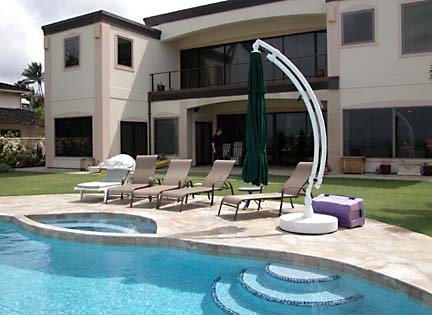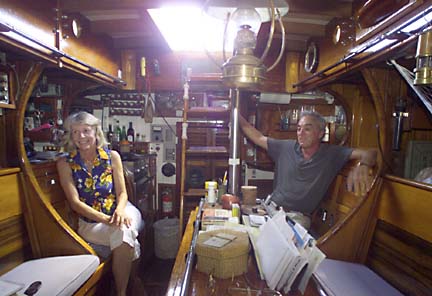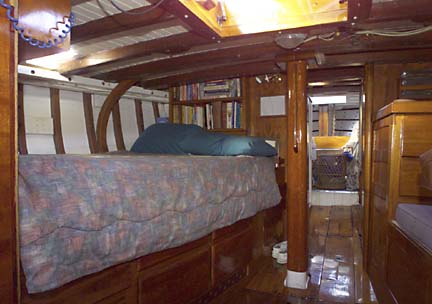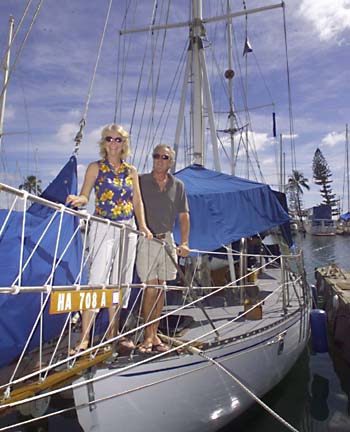
[ WATERFRONT HOME ]

|
Mastering their domain
Three to four miles of wiring support
the technology that controls a luxurious home
The "dream home" of Bruce and Helene Robin on the Portlock waterfront has brains as well as beauty. A home automation system that does almost everything except cook dinner is controlled by what Bruce Robin calls the "brains."
Different systems were integrated with "point and click" programming to operate the gates, doors, air-conditioning, security, telephone, video and lighting.
"We can pretty much do what needs to be done with a cell phone," Robin said. "If we're out to dinner and want the spa warmed and ready for us, we can do it by phone."
He figures the house has three to four miles of wiring going to the technology system. A generator can be activated in a power blackout.
Robin, a private pilot with a long-distance telecommunications business, said he used to sail in front of Portlock when the couple lived on Niuiki Circle and he thought it would be nice to live there.

|
When a real estate broker mentioned he was showing a house on the waterfront about 3 1/2 years ago, he looked at the 11,500-square-foot lot and bought it.
He tore down an existing house, drew up plans with an architect for a new one and a best friendÚcontractor built the home: 8,000 square feet under roof. The project was featured in The Little Grass Shack, a 13-week TV series.
The couple moved in July 2002 and Robin said he and the contractor are still best friends. "I'm happier (with the house) than I expected to be."
An obvious plus is the picturesque view of blue ocean and Diamond Head's back side. The Robins also enjoy the water with their trimaran and kayaks.
Helene Robin, retired human resources consultant, said most important to her in planning space were separate bathrooms in the 20-by-30-foot master bedroom, a gym where she regularly works out and a large kitchen.
About the only problem in the house, Robin noted, was a crinkle in the wood on all the kitchen cabinet doors, which had to be removed and refinished.

|
The home has four bedrooms, 6 1/2 baths, two offices and an elevator to the second floor. Stone and glass are featured throughout the rooms, with marble floors, counter tops and columns and a lot of glass block in the bathrooms.
Although the house is twice the size of their previous home, their electric bill is about two-thirds of what it was before because of high-efficiency air-conditioning and insulation rated R19 for winter climate, Robin said.
Comfortable furnishings and decorative items reflect the couple's interests. "We like stuff we can use," Robin said. "We don't want the place to be a show room."
They share the ocean with fishermen, boats and water sports enthusiasts. But Robin said, "We don't mind people on the beach. That's what the ocean is all about, to have fun."
[ BOAT HOME ]

|
Home, ahoy!
Space might be tight and the showers
are onshore, but life in a sailboat
goes swimmingly for the Bashaws
When you live on a sailboat, your front yard is the Pacific Ocean, and your property line runs to the horizon.
Twenty years ago, Tom Bashaw decided he would join the sailing life and buy a boat. Never mind that he didn't know how to sail or that he had never owned a boat.
Since then the 45-foot wooden ketch Kalua, an Australian aboriginal name meaning "sun princess," has been his home, his hobby and his passion. The boat was built in Tasmania two years before Bashaw was born.
"I learned to sail when I bought the boat. This is an old-style sailing vessel. It is like a living entity," Bashaw said.
"It is a simple way of life," said Bashaw, 56, who lives aboard his boat in a slip at the state's Ala Wai Small Boat Harbor.
He is one of 129 boat owners lucky enough to get a berth at the Ala Wai, where monthly rents are charged by the length of the boat, roughly about $9 a foot.

|
The state has dock space for 699 boats at the Ala Wai, according to Meghan Statts, Ala Wai harbor master, but only 129 are for people who permanently live on their boats.
Accommodations, however, are Spartan. Even a carefully maintained boat such as Bashaw's offers little extra space. If you want a hot shower, it is down the dock, not on board. The freshly varnished oak, koa and huon pine interior is immaculate and organized, but don't look for extra closets for storage.
"It tends to be more difficult for women because there is a lack of space for hanging clothes," Bashaw said.
Bashaw's wife, Carrie, left a five-bedroom house last year to marry and move in with Bashaw. She said she misses her washer and dryer but loves life on a boat. Together the couple bought a larger boat next door, which they are fixing up and plan to move into.
Boat living attracts a certain independent sort, said Wes Choi, harbor master of the Keehi Small Boat Harbor.
"Boaters as a whole are very independent, both from their natural personality and the requirements of sailing -- you have to have the confidence that you can take care of whatever emergency happens while you are at sea," said Choi, who watches over 22 live-aboard boaters in his 358-slip state harbor.

|
Home in a state-run small boat harbor has been a constant source of complaint and controversy for both boaters and the state.
The state auditor followed up in 2001 on an earlier audit, saying that the state was operating substandard harbors.
Bashaw agrees, but added that the fault is not with the boating division of the state Department of Land and Natural Resources, which operates the harbors.
The problem, Bashaw said, is a lack of money to address the problem. State Auditor Marion Higa estimated years of neglect would cost the state a minimum of $150 million to repair.
Former Gov. Ben Cayetano tried four times to convince the Legislature to allow the harbors to be leased to private businesses, but was continually rebuffed.
Now Gov. Linda Lingle has asked the counties if they would take over the 21 state harbors.
If that doesn't work, Peter Young, DLNR director, said the state "is investigating private partnerships for the management, maintenance and/or operation of its small boat harbors and launch ramps."
Changes to the ownership or setup of the harbors doesn't change the lifestyle for those now living in the harbor, Bashaw said.
"I guess it is a little like camping, but it is a lot better than camping because when you want to go to Maui, you just go and the house comes with you," Bashaw said.